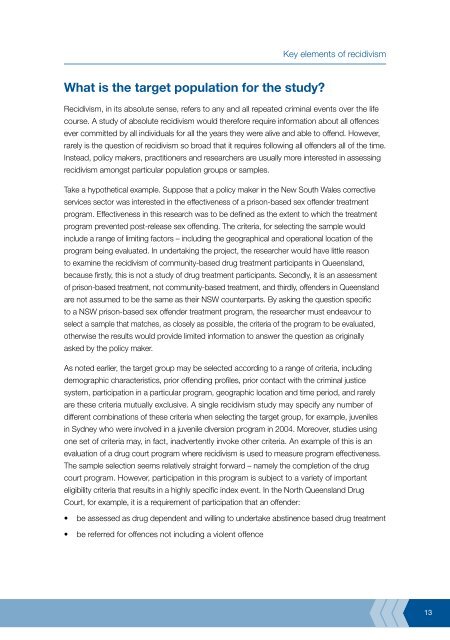Recidivism in Australia : findings and future research - Australian ...
Recidivism in Australia : findings and future research - Australian ...
Recidivism in Australia : findings and future research - Australian ...
Create successful ePaper yourself
Turn your PDF publications into a flip-book with our unique Google optimized e-Paper software.
What is the target population for the study?<br />
<strong>Recidivism</strong>, <strong>in</strong> its absolute sense, refers to any <strong>and</strong> all repeated crim<strong>in</strong>al events over the life<br />
course. A study of absolute recidivism would therefore require <strong>in</strong>formation about all offences<br />
ever committed by all <strong>in</strong>dividuals for all the years they were alive <strong>and</strong> able to offend. However,<br />
rarely is the question of recidivism so broad that it requires follow<strong>in</strong>g all offenders all of the time.<br />
Instead, policy makers, practitioners <strong>and</strong> <strong>research</strong>ers are usually more <strong>in</strong>terested <strong>in</strong> assess<strong>in</strong>g<br />
recidivism amongst particular population groups or samples.<br />
Take a hypothetical example. Suppose that a policy maker <strong>in</strong> the New South Wales corrective<br />
services sector was <strong>in</strong>terested <strong>in</strong> the effectiveness of a prison-based sex offender treatment<br />
program. Effectiveness <strong>in</strong> this <strong>research</strong> was to be def<strong>in</strong>ed as the extent to which the treatment<br />
program prevented post-release sex offend<strong>in</strong>g. The criteria, for select<strong>in</strong>g the sample would<br />
<strong>in</strong>clude a range of limit<strong>in</strong>g factors – <strong>in</strong>clud<strong>in</strong>g the geographical <strong>and</strong> operational location of the<br />
program be<strong>in</strong>g evaluated. In undertak<strong>in</strong>g the project, the <strong>research</strong>er would have little reason<br />
to exam<strong>in</strong>e the recidivism of community-based drug treatment participants <strong>in</strong> Queensl<strong>and</strong>,<br />
because firstly, this is not a study of drug treatment participants. Secondly, it is an assessment<br />
of prison-based treatment, not community-based treatment, <strong>and</strong> thirdly, offenders <strong>in</strong> Queensl<strong>and</strong><br />
are not assumed to be the same as their NSW counterparts. By ask<strong>in</strong>g the question specific<br />
to a NSW prison-based sex offender treatment program, the <strong>research</strong>er must endeavour to<br />
select a sample that matches, as closely as possible, the criteria of the program to be evaluated,<br />
otherwise the results would provide limited <strong>in</strong>formation to answer the question as orig<strong>in</strong>ally<br />
asked by the policy maker.<br />
As noted earlier, the target group may be selected accord<strong>in</strong>g to a range of criteria, <strong>in</strong>clud<strong>in</strong>g<br />
demographic characteristics, prior offend<strong>in</strong>g profiles, prior contact with the crim<strong>in</strong>al justice<br />
system, participation <strong>in</strong> a particular program, geographic location <strong>and</strong> time period, <strong>and</strong> rarely<br />
are these criteria mutually exclusive. A s<strong>in</strong>gle recidivism study may specify any number of<br />
different comb<strong>in</strong>ations of these criteria when select<strong>in</strong>g the target group, for example, juveniles<br />
<strong>in</strong> Sydney who were <strong>in</strong>volved <strong>in</strong> a juvenile diversion program <strong>in</strong> 2004. Moreover, studies us<strong>in</strong>g<br />
one set of criteria may, <strong>in</strong> fact, <strong>in</strong>advertently <strong>in</strong>voke other criteria. An example of this is an<br />
evaluation of a drug court program where recidivism is used to measure program effectiveness.<br />
The sample selection seems relatively straight forward – namely the completion of the drug<br />
court program. However, participation <strong>in</strong> this program is subject to a variety of important<br />
eligibility criteria that results <strong>in</strong> a highly specific <strong>in</strong>dex event. In the North Queensl<strong>and</strong> Drug<br />
Court, for example, it is a requirement of participation that an offender:<br />
•<br />
•<br />
be assessed as drug dependent <strong>and</strong> will<strong>in</strong>g to undertake abst<strong>in</strong>ence based drug treatment<br />
be referred for offences not <strong>in</strong>clud<strong>in</strong>g a violent offence<br />
Key elements of recidivism<br />
13















